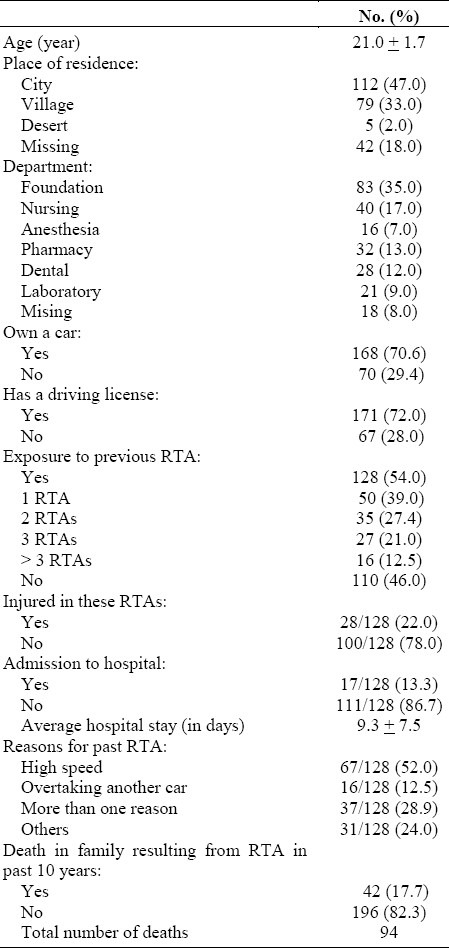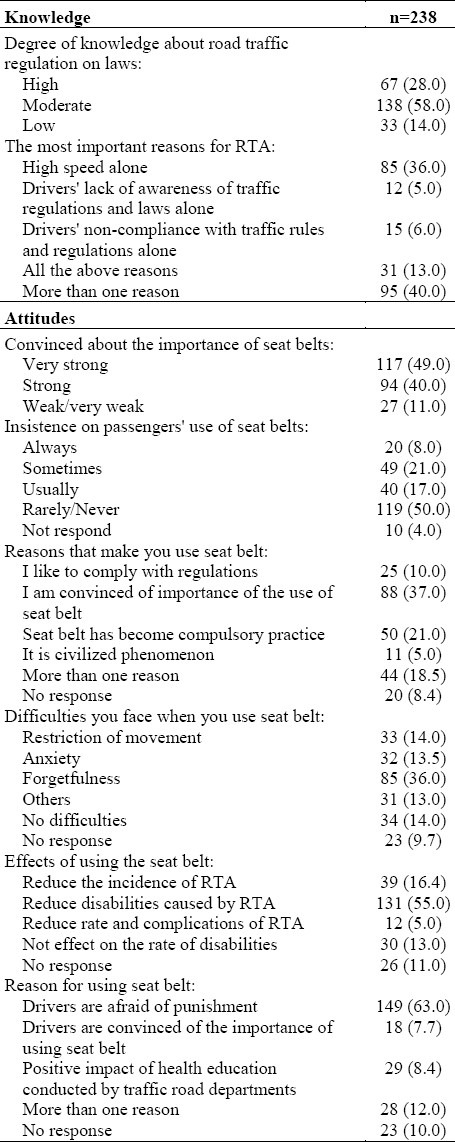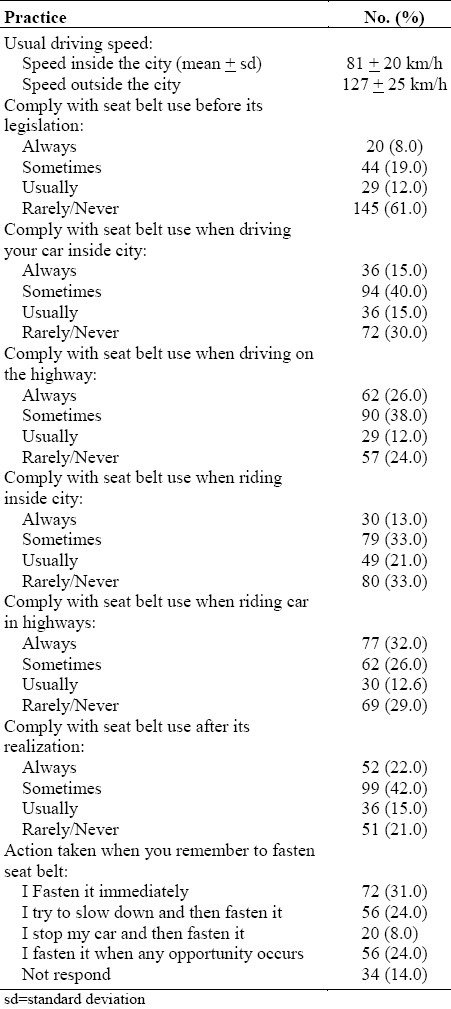Abstract
Objective:
The objectives of this study were to assess the knowledge, attitudes and practices of male students at the Health Science College in Abha, towards road traffic regulations.
Material and Methods:
This study was carried out during the second semester of the academic year 2002G among the students studying at the Health Science College for Boys in Abha, Aseer Region, Saudi Arabia. A questionnaire of 28 different questions was distributed to all available students and responded to under the direct supervision of the heads of the six departments of the college. The questionnaire consisted of three main parts; the first was about the socio-demographic and scientific data of the students; the second on the knowledge of road traffic regulations and the third dealt with attitudes and practice of driving and the use of seat belts.
Results:
Two hundred thirty eight out of 297 students (80%) responded to the questionnaire in this study. The mean age of the participants was 21 years, 47% lived in cities, 70% and 72% had cars and driving licenses respectively. More than half of the students had been involved in road traffic accidents (RTAs), 22% of these had been injured in these RTAs and 13% admitted to hospital for an average of nine days. High speed was the main cause of their RTAs. The mean speed at which the students drove their cars within and outside the city boundaries were 81 KM/h and 127 KM/h respectively.
The degree of knowledge of road traffic regulation was moderate to high in more than 75% of the students, while more than 90% of them believed in the importance of the use of seat belts. More than 75% of the participants mentioned that they had problems with the use of seat belts, the most common of which were forgetfulness and anxiety.
Conclusion:
This study revealed that many students had been involved in RTAs as a result of driving at high speed. Most of the students had good attitudes towards the use of seat belts. The rate of compliance to the use of seat belts increased with the legislation on its use. Continuing health education and the monitoring of compliance to road traffic regulations is necessary if the incidence of RTAs is to be reduced.
Keywords: Attitudes, Practice, Road Traffic Regulations, Students
INTRODUCTION
Road Traffic Accidents (RTA) form one of the leading causes of mortality and disability in Saudi Arabia.1 According to the mortality report of the Ministry of Health issued in 1425H (2004), during the years of 1418-1422 H, the total number of deaths due to RTAs was 20269.2 The majority of the dead were Saudi males between the ages of 25-40 years.2 Studies from the different regions of the Kingdom have shown that this health problem has increased.3,4 These studies discussed risk factors, incidence of RTA and stressed the importance of wearing seat belts in order to minimize the complications of this problem particularly among the young drivers, who formed the majority of those involved in RTAs.3,4 Although, the knowledge and attitudes of drivers towards road traffic regulations and safe driving have an important impact on RTA, few studies in Saudi Arabia have been conducted on this.5,6
The objective of this study was to assess the knowledge, attitudes and practice of students of the Health Science College for Boys in Abha, Southwest Saudi Arabia as they relate to road traffic rules and RTAs.
MATERIALS AND METHODS
This study was conducted during the second semester of the academic year 2002 among the students studying at the Health Science College for Boys in Abha, the capital city of the Aseer region, Southwest Saudi Arabia.
A questionnaire designed by the investigator was distributed to all the available students in the college through the heads of six different departments namely; Foundation, Nursing, Laboratory, Anesthesia, Pharmacy and Dentistry. This was completed under the direct supervision of the heads of the departments who returned them to the investigator on the same day.
The questionnaire consisted of 28 questions. The first group of questions was on the socio-demographic data: (age, education level, specialty, residence and ownership of car), and knowledge of road traffic laws. The second group of questions dealth with the attitudes to the use of seat belts and the practice of using seat belts while driving.
Data entry and analysis were carried out using Statistical Package of Social Sciences (SPSS). Student t-test and Chi-square test were used to test for significance when appropriate and (p-value was considered significant if it was less than 0.05).
RESULTS
The total number of the students studying in the Health Science College for Boys in Abha was 297 students. Two hundred and thirty-eight students (80%) responded to the questionnaire. Those who did not respond were absent on the day. Socio-demographic characteristics and past history of RTA among the students are shown in Table 1. The mean age of the students was 21 years, about one half of whom lived in the city (47%); more than one third were in the foundation year (35%), more than two thirds had cars (70.6%) and 72% had driving licenses.
Table 1.
Socio-demographic characteristics and previous RTA related events of students under the current study (n=238)

More than one half of the students (54%) had been involved in RTAs; 22% out of these had been injured and 13% had been admitted into hospital for 9.3 days. More than 50% of them indicated that speed was the main cause of the RTA.
Table 2 illustrates the knowledge, attitudes of students concerning RTA and other related issues. More than 50% of the students said that they had adequate knowledge of road traffic regulations and more than one third (36%) mentioned that high speed was the most important cause of RTAs.
Table 2.
Knowledge and attitudes of students concerning road traffic regulations and RTAs

When asked about the importance of the use of seat belts, about 90% were strongly convinced of its importance. However, on the reasons for using seat belts, 37% felt convinced of its use.
More than 85% reported that they had problems when their seat belts were fastened; more than half of the students thought that the use of seat belts reduced the disabilities caused by RTAs.
Table 3 shows the practice of students on seat belt use. The use of seat belts increased from 41% 79% after the legalisation came into force. However, it was found that students used their seat belts more frequently when driving on the highway (outside the cities) than when in the cities (town driving) (64% vs. 55%). On the use of seat belts as passengers within or outside the cities, the percentage fell to 46% and 58% respectively. When asked about what they would do if they forgot to fasten their seat belt, 31% responded that they would put them on immediately, while 24% said they would slow down and put them on.
Table 3.
Practice of students concerning road traffice regulations and RTAs

Statistical Analysis
Students who came from villages were found to drive faster than those living in cities (p=0.04). Students in the third level drove faster than those in second or first levels (p=0.006). Students who considered themselves more knowledgeable were found to drive faster than the others (p=0.002). Students who owned cars drove faster than those who had no cars (p=0.02).
DISCUSSION
Road traffic accidents (RTAs) are the result of many factors related to the car, driver, and the nature of the road. Though the car and the road contribute to some extent, driver errors remain the most significant factor in increasing or decreasing the rate of RTAs.6,7 As in any health problem, identification of the risk factors is essential, RTAs not excepted to preventing or reducing it. Attitudes and practice towards driving and the relevant road traffic regulation are the two significant contributing factors to RTAs in Saudi Arabia.7
Most of the students had cars (70%); perhaps because most Saudi families have cars. Seventy two percent of the students had driving licenses, and this is because all the students were above the legal age for owning a driver's license in Saudi Arabia (18 years old or above).
More than half of the students had been involved in RTAs which had resulted in 28 of them being injured with 17 admissions for 9.3 days on the average. The main reasons for RTA was high speed (52%). These findings were similar to those reported by many other investigators.3,7,8 About 18% of the students mentioned that they had lost at least one relative in a RTA in the previous ten years. This means that as reported by Ansari et al,7 the Saudi society has a major problem with RTAs.
Most of the students considered themselves knowledgeable about road traffic regulations. However, in the absence of comprehensive test of this part in the study, this response has to be viewed with caution. Most of the students mentioned that high speed and the non-compliance of drivers to road traffic regulations were the most common reasons for RTAs. These findings were in accord with what had been reported in previous studies.6–8
Though good attitudes can play a major role in changing the behavior and practice of individuals, this is hardly enough. In this study, it was obvious that the students were convinced about the importance of the use of seat belts and its impact on the reduction of disability from RTAs. However, many students used seat belts because of their fear of punishment resulting from non-compliance. These facts indicate that the implementation two years ago of the legislation on the compulsory use of seat belts was a step in the right direction.
The use of seat belts increased among the students as a result of the legislation (39% before compared to 79% after). These findings are higher than those reported from USA, different provinces in Saudi Arabia and some gulf states.5,9–11
There were some problems of attitude and practice in the compliance to this legislation. Since it was a new experience, more than 80% felt uneasy with the restriction of movement the seat belt imposed, were anxious or forgot to use it. As reported by Al-Gamdi, Bener and Shawan in three different studies these difficulties were expected.5,6,9
Differences in the use of seat belts by drivers and passengers were evident. We found that more people used their seat belts when driving than when they were passengers, and compliance to the regulation was more when driving or riding on the highway than within town.
These findings could be due to a misunderstanding of the regulation on seat belts and failure to understand that the law applied to both drivers and passengers, and to long as well as short distances. This misunderstanding could be corrected by ensuring that the rule is enforced both in town and on the highways, and both drivers and passengers who did not comply without medical justification were penalized.
Although, all of the students agreed to the importance of the rule to fasten seat belts, many of them neglected to use their seat belts for one reason or another. Reaction to forgetfulness varied among of students. Some of them put the belts on as soon as they remembered, some tried to slow down and put them on, while a few of the students stopped their cars to put them on. However, 24% of them put on the seat belts when they had the opportunity. Of course, the right thing to do is to stop the car completely at a lay-by and put on the seat belt in order to save lives.
CONCLUSION
This study revealed that many students had been involved in RTAs as a result of overspeeding. Most students knew the road traffic rules and understood the importance of the use of seat belts. The use of seat belts had increased after the legislation but there are still problems with compliance because of the negative attitudes and practice. This can only be addressed with aggressive enforcement of the regulation by the road traffic police.11
REFERENCES
- 1.Al-Tukhi MH. Road Traffic Accidents: Statistics and Data Comparing Gulf Countries and Riyadh Area. Saudi Medical Journal. 1990;11(1):1–3. [Google Scholar]
- 2.Saudi Arabia. Ministry of Health. Department of Statistics. Mortality Report of Ministry of Health Hospitals (1418-1422H). Riyadh. 14252H:177–190. [Google Scholar]
- 3.Badawi IA, Alakija W, Aziz MA. Road Traffic accidents In Asir Region, Saudi Arabia: Pattern and Prevention. Saudi Medical Journal. 1995;16(3):257–60. [Google Scholar]
- 4.Qayed MH. Epidemiology of road traffic accidents in Al-Ahssaa Governorate, Saudi Arabia. Eastern Mediterranean Health Journal. 1998;4(8):513–9. [Google Scholar]
- 5.Shawan S, Al-Arfaj A, Hegazi M, Al-Habdan I, Wsornu L. Voluntary usage of seat belts in the Eastern Province of Saudi Arabia. Saudi Medical Journal. 1992;13(1):25–8. [Google Scholar]
- 6.Al-Ghamdi KS. Behavior and practice of drivers towards road traffic safety at Naval Base in Jubail. Journal of Family and Community Medicine. 1995;2(2):41–8. (Arabic article) [Google Scholar]
- 7.Ansari S, Akhdar F, Mandoorah M, Moutaery K. Causes and effects of road traffic accidents in Saudi Arabia. Public Health. 2000;114(1):37–9. doi: 10.1038/sj.ph.1900610. [DOI] [PubMed] [Google Scholar]
- 8.Nofal FH, Saeed AA, Anokute CC. Aetiological factors contributing to road traffic accidents in Riyadh city, Saudi Arabia. J R Soci Health. 1996;116(5):304–11. doi: 10.1177/146642409611600508. [DOI] [PubMed] [Google Scholar]
- 9.Bener A, Arar E, Chemma MY. Injury Risk Reduction from Safety Seats Use. Saudi Medical Journal. 1992;13(3):254–6. [Google Scholar]
- 10.Pace BW, Thailer R, Kwiatkowski TG. New York State Seatbelt Law: Patterns of Seatbelt use before and after Legislation. Journal Trauma. 1986;26:1031–3. doi: 10.1097/00005373-198611000-00012. [DOI] [PubMed] [Google Scholar]
- 11.Mufti MH. Medico-legal Aspects of Seat Belt Legislation in Saudi Arabia. Saudi Medical Journal. 1986;7(1):84–90. [Google Scholar]


